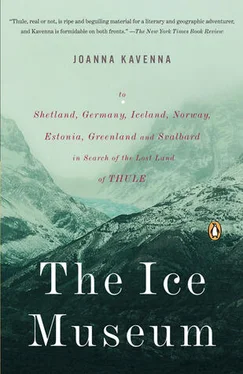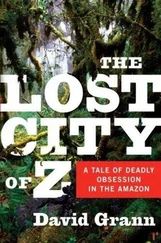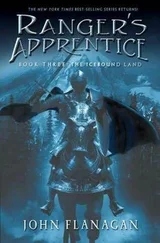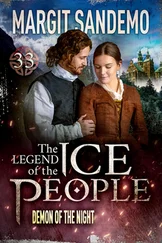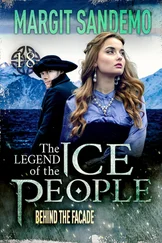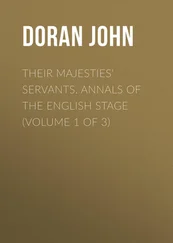The small wooden houses were reflected in the clear waters of the fjords; the rain fell softly onto the verdant plains.
And during the next day the boat moved slowly along the coast of Nordmøre, through archipelagoes of rocks coated with moss, layered with trees, everything shimmering under the heat haze. The boat passed into the clear waters of Trondheimsleia, with the rocks a brilliant blue under the fine silvery light. There were cornfields to starboard, bright against the deep green of the woodland. Stretching beyond were miles and miles of green and grey coastline: slender trees on stark rocks, brilliant patches of sunlight falling onto the dusty mountains. Pytheas, Nansen thought, would have sailed along the coast to the gentle plains of Trøndelag, the area around Trondheim, and towards the pallid clenched claws of the mountains further along the coast.
I was lulled by the motion of the ship. The landscape was grandiose, but its shifts were subtle and regular; changes in terrain were gradually realized, signalled from the south, as the trees dwindled on the slopes, and the forests gave way to rocks. The sky swelled, the sea darkened, the sun sank towards the horizon, and failed to disappear. A burnt glow fell across the waves; the long lines of the mountains receded into shadows.
In my early twenties, I had lived outside Trondheim for a few months, and I knew Nansen’s Thule well. It was a place where I had watched the summer fall into a rust-coloured autumn, the trees slowly shedding their leaves. The trees lost their leaves to the slow creep towards winter, the light started to weaken, declining into a mid-afternoon dusk. The sun couldn’t cling to the skies. I lived in a hut by a fjord and walked through the twilight mornings, across fields dusted with a light coating of snow, a coating which thickened as the winter became darker. The stillness was what most affected my mood; I had thought the long nights would drag me into inertia, but I found waking to a silent field of ice, the only motion the snow gliding onto the windowsill, created a mood of exhilaration. The snow shone, a white plain sharply distinguished from the darkness of the sky; everything was bold and uncomplicated. My hut was two miles from a small village, so some mornings I would walk there, across untouched snow, my feet denting the crisp surface, pushing through to the ground beneath. Everyone was quiet and friendly in this snow world; they waved from a distance, farmers walking in their fields, and people who by summer might try to fish in the fjords, waiting through the cold months. They waved and turned away, retreating from the ice-winds back to their houses. It was beautiful but it was impossible to walk for more than an hour in the cold air; it made my lungs ache, and my abiding memory of the time I spent outside Trondheim was the yearning for warmth in any form, an addiction to hot baths, saunas and open fires. I walked through the fields, thinking of where and how I would next become warm.
By the end I was almost acclimatized, I could walk through the winds as they blasted snow in my eyes, and in England for a while I was never cold.
The crisp coldness of the air made me think quickly; I wrote letters to everyone I knew, generating reams of paper which I stacked in a pile and tried not to use as firelighters. I read Knut Hamsun, the Norwegian Nobel laureate, who had loved the Nordland summer’s endless day, the long light evenings, the rustling of the leaves in the forest, the darting of the light across the fjord. The skies of pale fire, the drift of the season into winter. Hamsun had started out in the 1890s as a crazy brilliant modernist, writing out the madness of the city and the desperation of the starving writer, in the reeling prose of Hunger . He had come from a small town north of Trondheim; he was from a poor family, and no one encouraged him to write; he passed his twenties as a mendicant, struggling to survive, emigrating to the States in search of something else, declining into a dozen piecemeal jobs. Hunger was the product of a raging and desperate frustration, his ravenous urge to succeed. Success began to ruin Hamsun; he became obsessed with his own rise from obscurity, his novels started to talk of nothing else. He became nostalgic and impatient; he lurched away from the city, writing nothing but rustic romances laced with sentimentality, tales of robust hunting men of few words, clumsy in elegant company, chasing the daughters of local merchants through the vibrant forests. They lived in huts like mine, they wore big boots, they knew nothing of manners and conventions; they were tormented brutes, aware that society judged them. They were good at whittling wood, and occasionally sheer frustration at their failure to ensnare a local beauty led them to a melodramatic act. One of the rustic hut-dwellers shot himself in the foot one morning because the beautiful daughter of the local businessman wouldn’t talk to him.
I had sat in the hut, the snow stacked up outside the door, reading Hamsun’s odes to rustic simplicity.
When the ship slips past the Arctic Circle, there is no fanfare, no signal from the shore. There is a terse announcement from the bridge at 7 A.M. The landscape stays the same; the same stark crags and tree-coated rocks lounging low in the fjord. Streaks of ice and snow glint on the tops of the mountains. There’s an island ahead, coated in red firs. In the small Arctic town of Ørnes, the sound of the ship’s horn echoes around the mountains. We have reached another defiant, isolated place: a few elegant old buildings by the quayside, smaller houses stretching up the hillside. A sand beach slides down to the ocean; it is deserted, though the sun shines across it. Anywhere here, I imagine Nansen muttering to himself, as he saw these sun-drenched rocks. Pytheas might have arrived anywhere around here, and called it Thule. Here, where a lone crag casts a long shadow over the water, or here, on this barren islet, a thin coating of moss clinging to the rock. Thule as Nansen saw it is a place of wooden houses, in red, yellow and green, topped with slanted roofs. Lines of rorbuer —fishermen’s huts—along the water’s edge. The crushed peaks of the mountains, severe slices of granite colliding into irregular shapes, perverse dodecahedrons, drawn by a hyperactive hand. Then there are places where the mountains lurk like squat rock beasts, behind the long flat islands. It’s a staggering land, constantly inventive and showy, producing new wonders of scenery. It’s a place where the people are silenced by the immensity of the rocks, left staring quietly at the sea. Purple mountains rise in the distance, and the only sounds are the cries of gulls, twirling in the boat’s wake, and the relentless sluicing of water under the hull. The fjord absorbs the colours of the sky; the sun casts a low haze across the mountains; the mountains reflect their shapes across the fjord.
It’s a hot afternoon; the sun is shining onto the waves. The ship stops at Bodø, a small Arctic outpost. The mountains are beautiful. The sea is serene and glitters in the sun. The town is a collapsed street, diggers slamming into the cracked concrete, military aircraft screaming across the skies. There’s a shopping centre in a state of destruction, with wire fences everywhere. The area was ruined at the end of the Second World War, when the Germans retreated from the Russian forces moving from the east. Bodø is a town of concrete blocks, interspersed with neat wooden buildings, rebuilt when the inhabitants returned home after the war. A memorial stands outside Bodø Cathedral: ‘To the Memory of those from Bodø who gave their lives for Norway during the War and the Occupation 1940-45.’ Cast adrift in Nansen’s Thule, startled by the sun, I dive into the regional museum, and find a sketchy collection of junk and fishing tackle, distributed randomly across a couple of rooms. There’s a large photograph of the town in 1939, before the destruction—rows of wooden houses, quaint and nondescript. And there’s a shot of the town after the war—piled-up ash and debris, silence and thick smoke.
Читать дальше
